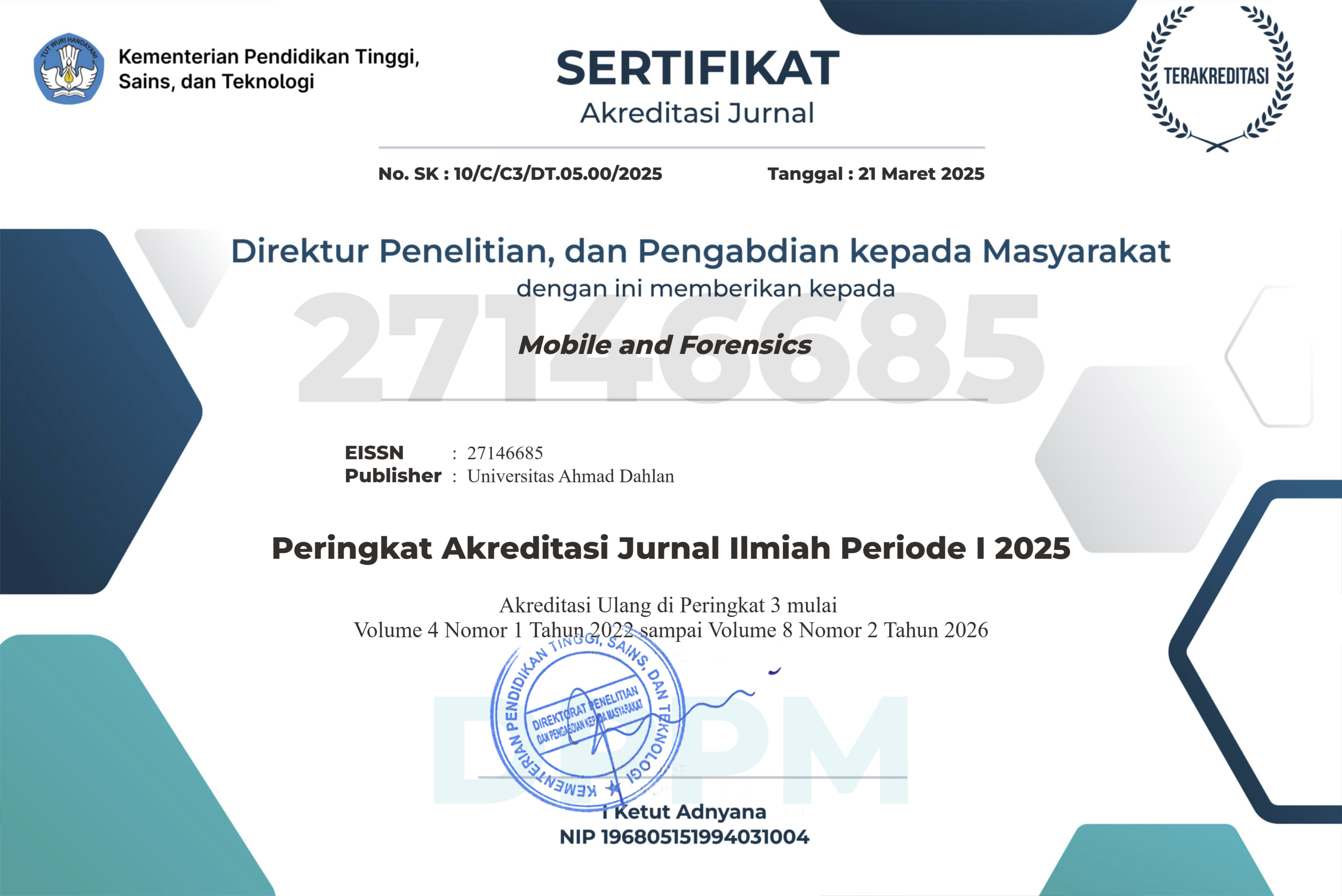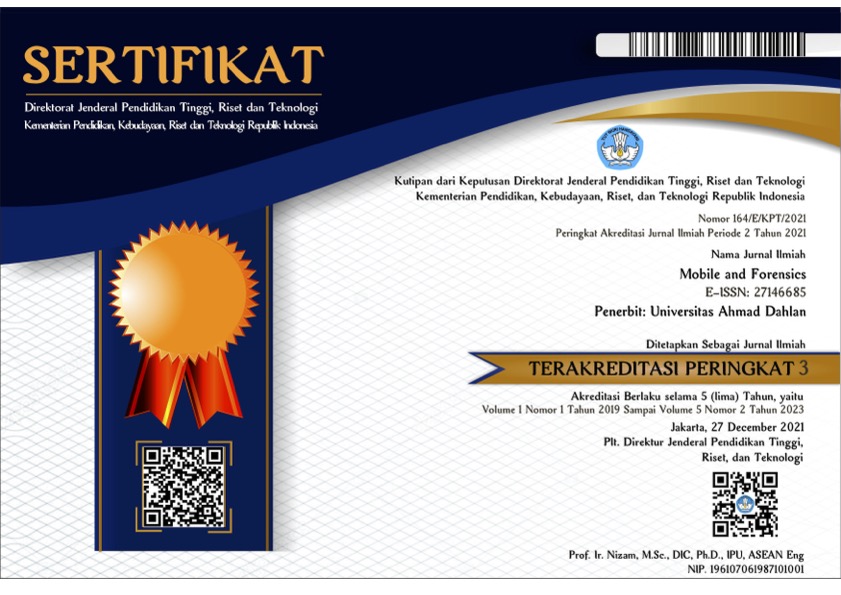Embedded System for Automatic Mask Detection using YOLOv4 Deep Learning and PyQt5 Interface
DOI:
https://doi.org/10.12928/mf.v7i1.11951Keywords:
Multi-face Mask, Embedded System, Raspberry Pi, YOLOv4, PyQt5Abstract
The use of masks remains crucial, especially in high-risk areas for disease transmission, such as airports, schools, hospitals, and crowded places. However, some individuals continue to neglect wearing masks in these locations, leaving the area vulnerable to disease spread, including COVID-19. Therefore, this study proposes the development of an embedded system based on Raspberry Pi 4 for automatic mask detection using YOLOv4 deep learning and a PyQt5 interface. The system is designed to be simple and compact, featuring a user-friendly GUI to effectively detect mask usage on multiple faces in a single detection. Experimental results on 40 samples captured in real-time, with 4 samples taken per image capture and various mask colors and three mask-wearing angles, demonstrated that the average precision, recall, and F1_score rates were each 100%. This outcome proves that the proposed embedded system successfully detects masks on multiple faces with different colors and angles in a single detection with excellent accuracy.
References
I. S. Joyosemito and N. M. Nasir, “Gelombang Kedua Pandemi Menuju Endemi Covid-19: Analisis Kebijakan Vaksinasi Dan Pembatasan Kegiatan Masyarakat Di Indonesia,” 2021. doi: 10.31599/jstpm.v2i1.718.
R. Filip, R. Gheorghita Puscaselu, L. Anchidin-Norocel, M. Dimian, and W. K. Savage, “Global challenges to public health care systems during the COVID-19 pandemic: a review of pandemic measures and problems,” J. Pers. Med., vol. 12, no. 8, p. 1295, 2022.
M. R. Abdul Rashid et al., “COVID-19 pandemic fatigue and its sociodemographic, mental health status, and perceived causes: a cross-sectional study nearing the transition to an endemic phase in Malaysia,” Int. J. Environ. Res. Public Health, vol. 20, no. 5, p. 4476, 2023.
H. Goyal, K. Sidana, C. Singh, A. Jain, and S. Jindal, “A real time face mask detection system using convolutional neural network,” Multimed. Tools Appl., vol. 81, no. 11, pp. 14999–15015, 2022.
A. Nofiar and Muhammad Ridwan, “Alat Pendeteksi Ketepatan Penggunaan Masker Berbasis Arduino Menggunakan Bahasa Pemrograman Python,” SATIN - Sains dan Teknol. Inf., vol. 8, no. 1, pp. 69–81, 2022, doi: 10.33372/stn.v8i1.835.
F. A. Hermawati and R. A. Zai, “Sistem Deteksi Pemakaian Masker Menggunakan Metode Viola-Jones dan Convolutional Neural Networks (CNN),” in Konferensi Nasional Ilmu Komputer (KONIK) 2021, 2021, pp. 182–187. [Online]. Available: https://www.kaggle.com/prithwirajmitra/covid-face-mask-
M. Aminullah, “Alat Deteksi Masker Dengan Metode Convolutional Neural Network Untuk Tunanetra Pada Era New Normal,” in Seminar Nasional Fortei Regional 7, 2020, pp. 321–324.
R. F. Muharram and A. Suryadi, “Implementasi artificial intelligence untuk deteksi masker secara realtime dengan tensorflow dan ssdmobilenet Berbasis python,” J. Widya, vol. 3, no. 2, pp. 281–290, 2022, [Online]. Available: https://jurnal.amikwidyaloka.ac.id/index.php/awl
F. L. Ahmad, A. Nugroho, and A. F. Suni, “Deteksi Pemakai Masker Menggunakan Metode Haar Cascade Sebagai Pencegahaan COVID 19,” Edu Elektr. J., vol. 10, no. 1, pp. 13–18, 2021.
G. Aprilian Anarki, K. Auliasari, and M. Orisa, “PENERAPAN METODE HAAR CASCADE PADA APLIKASI DETEKSI MASKER,” JATI (Jurnal Mhs. Tek. Inform., vol. 5, no. 1, pp. 179–186, 2021, doi: 10.36040/jati.v5i1.3214.
R. R. Ramdhani, R. I. Adam, and A. A. Ridha, “Implementasi Deep Learning Untuk Deteksi Masker Deep Learning Implementation for Face Mask Detection,” J. Inf. Technol. Comput. Sci., vol. 4, no. 2, p. 2021, 2021.
A. Bochkovskiy, C.-Y. Wang, and H.-Y. M. Liao, “YOLOv4: Optimal Speed and Accuracy of Object Detection,” arXiv Prepr. arXiv2004.10934, pp. 1–17, 2020, doi: 10.48550/arXiv.2004.10934.
L. Agustien, T. Rahman, and A. W. Hujairi, “Real-time Deteksi Masker Berbasis Deep Learning menggunakan Algoritma CNN YOLOv3,” J. Teknol. Inf. dan Terap., vol. 8, no. 2, pp. 129–137, 2021, doi: https://doi.org/10/25047/jtit.v8i2.246.
Z. Jiang, L. Zhao, S. Li, and Y. Jia, “Real-time object detection method for embedded devices,” in computer vision and pattern recognition, 2020, pp. 1–11.
N. Klingler, “YOLOv4: A Fast and Efficient Object Detection Model - viso.ai.” Accessed: Feb. 25, 2025. [Online]. Available: https://viso.ai/deep-learning/yolov4/
U. Nepal and H. Eslamiat, “Comparing YOLOv3, YOLOv4 and YOLOv5 for autonomous landing spot detection in faulty UAVs,” Sensors, vol. 22, no. 2, p. 464, 2022.
“YOLOv5 Model License and Pricing.” Accessed: Feb. 25, 2025. [Online]. Available: https://roboflow.com/model-licenses/yolov5
B. Gabrial, S. Tangkuman, and J. Rantung, “Rancang Bangun Aplikasi Perancangan Roda Gigi Lurus Menggunakan Bahasa Pemrograman Python,” J. Tekno Mesin, vol. 10, no. 1, pp. 1–8, 2024, doi: https://doi.org/10.35793/jtm.v10i1.51990.
H. M. Alfarisi, “GitHub - HaiqalLM10/FaceMaskYOLOv4: Face Mask Detection with YOLOv4 dan Darknet (Indonesian).” Accessed: Jun. 14, 2024. [Online]. Available: https://github.com/HaiqalLM10/FaceMaskYOLOv4
S. Singha and B. Aydin, “Automated Drone Detection Using YOLOv4,” Drones, vol. 5, no. 3, p. 95, Sep. 2021, doi: 10.3390/drones5030095.

Downloads
Published
Issue
Section
License
Copyright (c) 2025 Arif Fadllullah, Nelson Mandela Rande Langi, Ikhsan Maulana, Laura Nur Meilindy, Muhammad Adhiya Yudhistira Akbar, Mukti Dika Rahman

This work is licensed under a Creative Commons Attribution-ShareAlike 4.0 International License.
Start from 2019 issues, authors who publish with JURNAL MOBILE AND FORENSICS agree to the following terms:
- Authors retain copyright and grant the journal right of first publication with the work simultaneously licensed under a Creative Commons Attribution License (CC BY-SA 4.0) that allows others to share the work with an acknowledgment of the work's authorship and initial publication in this journal.
- Authors are able to enter into separate, additional contractual arrangements for the non-exclusive distribution of the journal's published version of the work (e.g., post it to an institutional repository or publish it in a book), with an acknowledgment of its initial publication in this journal.
- Authors are permitted and encouraged to post their work online (e.g., in institutional repositories or on their website) prior to and during the submission process, as it can lead to productive exchanges, as well as earlier and greater citation of published work.

This work is licensed under a Creative Commons Attribution-ShareAlike 4.0 International License.












 Mobile and Forensics (MF)
Mobile and Forensics (MF)